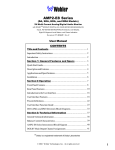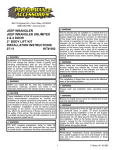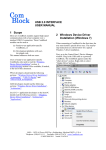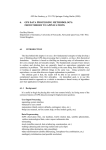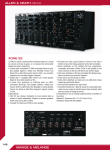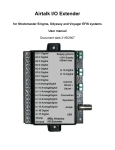Download Wohler VMSDA-1 User manual
Transcript
VM SDI Digital Series 1U Analog/Digital Audio Monitors (VMSDA-1 and VMMDA-1) Document P/N 821625 Rev-A with One SDI or SDI and HD-SDI Input and Re-clocked Output on BNC, One AES input on BNC or Phoenix, Analog input on "mini" Phoenix, SDI Group Eight Channel Pair selection, Stereo Analog Output of Selected Source on "mini" Phoenix, Two 10-Segment Level Meters, and Phase Indication User Manual CONTENTS Title and Contents ........................................................ 1 Introduction .......................................................................... 2 Section 1: Features, Specs, and Installation ...... 3 Description and Features ....................................................... 4 Applications and General Specifications ................................. 5 Installation ............................................................................. 6 Section 2: Operation .................................................... 7 Front Panel Features .............................................................. 8 Rear Panel Features ............................................................... 10 Audio Amplifier and Speaker Configuration ........................... 12 Balance Control Characteristics .............................................. 12 Section 3: Technical Information ............................ 13 General Technical information ............................................... 14 VM Main PCB (P/N 919141-1)Trimpot Locations..................... 15 VM SDI Digital Series Interconnect Block Diagram ................. 16 © 2005 Wohler Technologies Inc. ALL rights reserved 1 Important Safety Instructions 1) Read these instructions. 2) Keep these instructions. 3) Heed all warnings. 4) Follow all instructions. 5) Do not use this apparatus near water. 6) Clean only with dry cloth. 7) Do not block any ventilation openings. Install in accordance with the manufacturer's instructions. 8) Do not install near any heat source such as radiators, heat registers, stoves, or other apparatus (including amplifiers) that produce heat. 9) Do not defeat the safety purpose of the polarized or grounding-type plug. A polarized plug has two blades with one wider than the other. A grounding type plug has two blades and a third grounding prong. The wide blade or the third prong are provided for your safety. If the provided plug does not fit into your outlet, consult an electrician for replacement of the obsolete outlet. 10) Protect the power cord from being walked on or pinched, particularly at plugs convenience receptacles and the point where they exit from the apparatus. 11) Only use attachments/accessories specified by the manufacturer. 12) Use only with the cart stand, tripod, bracket, or table specified by the manufacturer, or sold with the apparatus. When a cart is used, use caution when moving the cart/apparatus combination to avoid injury from tip-over. 13) Unplug this apparatus during lightning storms or when unused for long periods of time. 14) Refer all servicing to qualified service personnel. Servicing is required when the apparatus has been damaged in any way, such as when power-supply cord or plug is damaged, liquid has been spilled or objects have fallen into the apparatus, the apparatus has been exposed to rain or moisture, does not operate normally, or has been dropped. 15) Do not expose this apparatus to rain or moisture. 16) The apparatus shall be connected to a mains socket outlet with a protective earthing connection. CAUTION! In products featuring an audio amplifier and speakers, the surface at the side of the unit, where the audio amplifier heat sink is internally attached, may get very hot after extended operation. When operating the unit excercise caution when touching this surface and ensure that external materials which may be adversely affected by heat are not in contact with it. There is a Hot Surface label (see diagram) attached to the aforementioned surface of the product. Introduction Congratulations on your selection of a Wohler Technologies product. We are confident it represents the best performance and value available, and we guarantee your satisfaction with it. If you have questions or comments you may contact us at: Wohler Technologies, Inc. 31055 Huntwood Avenue Hayward, CA 94544 Phone: (510) 870-0810 Fax: (510) 870-0811 US Toll-Free: 1-888-596-4537 www.wohler.com 2 [email protected] © 2007 Wohler Technologies, Inc. ALL rights reserved VM SDI Digital Series User Manual P/N 821625 Rev-A Sect. 1: General Features and Specifications Section 1 General Features, Specifications, and Installation Description Features Applications General Specifications Installation © 2005 Wohler Technologies Inc. ALL rights reserved 3 VM SDI Digital Series User Manual P/N 821625 Rev-A Section 1: General Features, Specifications, and Installation VM SDI Digital Series Analog/Digital Audio Monitors Models: VMSDA-1 and VMMDA-1 VMSDA-1 Front Panel VMMDA-1 Front Panel Description The single-rackspace VM SDI Digital Series audio monitors permit stereo monitoring with excellent fidelity exceeding that of ordinary monitors. In this series the VMSDA-1 monitors analog, AES, and standard SDI audio sources while the VMMDA-1can monitor analog, AES, standard SDI, or HD-SDI audio sources. A 3-position toggle switch on the front panel selects between the three input sources (analog, AES, or SDI). When SDI is selected as the source, an 8-position rotary SDI Group Select switch selects which of the eight SDI channel pairs will be monitored. An LED above the SDI Group Select switch indicates the "lock" status of the SDI source. Both models feature dual 10-segment LED bargaph meters that provide visual indication of input levels. Other front panel features include volume and balance controls, power indication LED, headphone output, and phase indication LEDs. Wohler Technologies proprietary three-LED stereo phase indication feature allows monitoring of phase relationships of the selected stereo inputs.Volume and balance controls are standard, but can be reconfigured as A volume/B volume via an internal jumper. Two front-firing midrangetweeter speakers and a compact high-performance woofer are arranged in Wohler Technologies’ popular bi-amp design. The summed bass feature is important for audible detection of “out of phase” conditions. Speaker amp limiters prevent accidental damage to speakers from high input levels. The rear panel features an SDI input and output on BNC connectors, an AES input on a BNC and Phoenix connector, two analog inputs on Phoenix connectors, and an analog stereo output of the selected source on Phoenix connectors. Features • Only one rack space high, but produces a powerful 96 dB SPL @ 2 feet • Volume and Balance controls (jumper-configurable as Avolume/B-volume) • VMSDA-1 model monitors analog, AES, and SD-SDI audio sources • Headphone jack • VMMDA-1 model monitors analog, AES, and SD-SDI or HD-SDI audio sources • Source selected using a front panel 3-position toggle switch (analog, AES, or SDI) • Eight channel pairs from SDI Groups 1-4 selectable with front panel rotary switch (when SDI is the selected source) • Two analog inputs on Phoenix connectors • AES input on balanced Phoenix connector and unbalanced BNC connector • Selectable termination on AES input • SDI input and re-clocked output on BNC connectors • LED indicates SDI "lock" status • Balanced stereo analog output of selected source on Phoenix connectors • Two 10-segment LED bargraph audio level meters • Thoroughly magnetically shielded • Phase indication LEDs • Internal universal AC mains power supply • Power indication LED 4 © 2005 Wohler Technologies Inc. ALL rights reserved VM SDI Digital Series User Manual P/N 821625 Rev-A Section 1: General Features, Specifications, and Installation Applications The VM SDI Digital Series of audio monitors are ideally suited to provide high quality analog/digital audio monitoring in a very compact form. Ideal for use in VTR bays, mobile production vehicles, teleconferencing installations, multimedia systems, satellite links, cable TV facilities, and on-air radio studios, both models are manufactured in the U.S.A. and are backed by a strong warranty and a satisfaction guaranteed return policy. General Specifications Peak Acoustic Output: (@ 2 ft.) AES Input Impedance: 75 and 110 Ω termselect AES Input Sampling Rate: 32-48k Hz, auto-sensing SDI Input Sampling Rate: 48k Hz Level Meter Type: LED bargraph Bargraph Quantity: 10-segment LED Color: Tri-color (red, amber, green) Metering Range: 23 dB Magnetic Shielding: Less than 0.2 gauss any adjacent surface Power Supply: Internal universal AC input (100-240V) Chassis Dimensions (H x W x D): 1.75 x 19 x 10 in. (44.5 x 483 x 254 mm.) Weight: 6.8 lbs. (3.1kg) 96 dB SPL Input Level for Full Output (Volume Full On): Analog: 0 dBv balanced Digital: 20 dBfs Acoustic Distortion: Typically < 2% at any level below limiting, 100Hz-15KHz Acoustic Frequency Response: 60 Hz to 16 kHz (± 6dB) Hum and Noise, Analog: Better than -70 dB below full output Electrical Distortion: > 0.3% at any level below limit threshold Input Connectors: Analog: "mini" Phoenix (bal). x 2 AES: "mini" Phoenix x1, BNC x 1 SDI/HD-SDI: BNC x 1 Output Connectors: Analog (Selected): "mini" Phoenix x 2 SDI (re-clocked): BNC x 1 Analog Input Impedance: >100k Ω, balanced +10 0 d B -10 -20 -30 20 50 100 200 500 1k 2k 5k 10k 20k Hz Typical 1/6 Octave Audio Response Curve Units are certified to meet, at time of manufacture, all currently applicable product safety and EMC requirements, such as those of CE. 0 dbV ref. 0.775V RMS. Features and specifications subject to improvement without notice. © 2005 Wohler Technologies Inc. ALL rights reserved 5 VM SDI Digital Series User Manual P/N 821625 Rev-A Section 1: General Features, Specifications, and Installation Installation Mounting The unit should be mounted where convenient for operating persons, ideally at approximately ear level for best high frequency response. Its superior magnetic shielding eliminates concerns about locating it adjacent to most types of CRT monitors, including even high-resolution color monitors. Heat Dissipation Heat dissipated by the speaker amps is conducted directly to the left side of the chassis; no special considerations for cooling are necessary as long as the ambient temperature inside the rack area does not exceed approximately 40°C (104°F). Sympathetic Vibration Sympathetic vibration from other equipment (cables, etc.,) in the rack may be serious enough to interfere with the unit’s sound quality out in the listening area. The use of thin card stock and/or felt or foam weather-stripping type materials between adjacent vibrating surfaces, or tying up loose cables, etc., may be required to stop vibrations external to the unit. Mechanical Bracing The chassis is securely attached to the front panel at eight points along its surface, not just at the four corners of the chassis ears. This feature will reduce or eliminate rear bracing requirements in many mobile/portable applications. The weight of internal components is distributed fairly evenly around the unit. Audio Connections Connection of the audio feeds is straightforward. See the Rear Panel Features section on page 10 and the interconnect block diagram on page 12 for information about audio connections. Electrical Interference Care should be exercised to avoid mismatched cable types and other similar causes of undesired reflections in digital signal systems. If severe enough, such reflections can result in corruption of the digital datastream. AC Power The unit's AC mains connection is via a standard IEC inlet, with safety ground connected directly to the unit's chassis. The universal AC input (100-240VAC, 50/60Hz) switching power supply is a self-resetting sealed type, with automatic over-voltage and overcurrent shutdown. There is no user-replaceable fuse in either the primary or secondary circuit. 6 © 2005 Wohler Technologies Inc. ALL rights reserved VM SDI Digital Series User Manual P/N 821625 Rev-A Section 2 Operation Front Panel Features Rear Panel Features © 2005 Wohler Technologies Inc. ALL rights reserved 7 VM SDI Digital Series User Manual P/N 821625 Rev-A Section 2: Operation Front Panel Features Please refer to Figure-2a on the facing page to familiarize yourself with the front panel features of the VM SDI Digital Series units. The following sections describe these features and are referenced, by number, to Figure-2a. Note that even though only the VMMDA-1 front panel is shown, features and operation are identicle for the VMSDA-1. 1 Speakers (Left, Right, and Woofer) The VM SDI Digital Series audio monitors feature two mid-range speakers (left and right) and one woofer speaker. See page 12 for a description and diagram of the audio amplifier and speaker configuration. 2 Volume Control This adjusts the loudness of the audio reproduced by the internal speaker channels or connected headphone. 3 Audio Level Meter Bargraphs (Left and Right) Audio levels for the selected source channels (left and right) are displayed via these two 10-segment LED bargraph audio level meters. Meters have a dynamic range of 23 dB and levels are displayed using both VU and PPM dynamics. 4 SDI Lock Status LED This LED indicates the lock status of the SDI source signal. It glows GREEN to indicate a locked SDI signal and is unlit to indicate an unlocked SDI signal (or that no SDI source is connected). This LED indicates SDI lock status continuosly regardless of any other selection settings. 5 SDI Group Channel Select Switch This 8-position rotary switch selects one of the eight channel pairs (from SDI Groups 1-4) that will be monitored from the connected SDI source. Note that in order to audibly monitor the selected SDI channel pair, the Source Select Switch (Item 10) must be set to SDI. 6 Headphone Jack This jack accepts the standard 1/4” phone type stereo plug. Select the headphone audio sources as you would for the internal speakers. When you plug in headphones the speakers will mute. 7 Power Indication LED This LED glows GREEN to indicate the unit is connected to mains power and an operation voltage is present. 8 Balance Control This control adjusts the volume balance between the left and right speaker channels. See page 12 for a description of the balance control characteristics within the amplifier and speaker configuration. 9 Phase Indication LEDs These three LEDs indicate the instantaneous and average phase (polarity) conditions between the two signals in the channel pair assigned to the left and right speaker channels. The two smaller LEDs labeled FAST show instantaneous phase relationships in the signal. The larger LED labeled AVG will indicate the average phase condition. Indication is as follows: • The left FAST LED glows (or blinks) GREEN for in-phase signals. • The right FAST LED glows (or blinks) AMBER for out-of-phase signals. • The large AVG LED indicates the average phase condition by glowing GREEN for in-phase signals, or RED for out-of-phase signals. In general, observing the AVG LED alone is sufficient for proper phase monitoring. While it is normal for stereo signals to contain some intermittant instantaneous out-of-phase and in-phase conditions (FAST LEDs), a steady RED glow of the AVG LED indicates an out-of-phase alarm condition. 10 Source Select Switch This 3-position toggle switch selects the source to be monitored through the unit (SDI, AES, or analog). 8 © 2005 Wohler Technologies Inc. ALL rights reserved VM SDI Digital Series User Manual P/N 821625 Rev-A Section 2: Operation Figure-2a: Front Panel Features © 2005 Wohler Technologies Inc. ALL rights reserved 9 VM SDI Digital Series User Manual P/N 821625 Rev-A Section 2: Operation Rear Panel Features Please refer to Figure-2b on the facing page to familiarize yourself with the rear panel features of the VM SDI Digital Series units. The following sections describe these features and are referenced, by letter, to Figure-2b. A Power Connector Attach the supplied IEC-320 power cord between this connector and mains power. B C SDI Input Connector This BNC input connector (SDI IN) is configured for unbalanced, 75 Ω impedance connections. In the VMSDA-1 model, this input accepts standard SDI formatted digital signals. In the VMMDA-1 model, this input accepts either standard SDI or HD-SDI (high-definition SDI) formatted digital signals. To monitor the digital source signals entering this input connector, set the Source Select Switch (Item 10, page 8) to SDI. Note: The SDI Lock Status LED (Item 4, page 8) will continue to indicate SDI lock status for this input even when the SDI source is not selected for monitoring. SDI Output Connector This BNC connector (SDI OUT) outputs a reclocked (regenerated) copy of the signal entering the SDI Input Connector (Item B). D Analog Output Connector (Left and Right) This "mini" Phoenix style (Mini-Combicon) dual vertical, 6-position terminal block connector outputs an analog signal of the source currently selected for monitoring. When the selected source is digital (AES, SDI, or HD-SDI), the unit will automatically de-embed the audio to analog for output from this connector. The top three positions are the left output; the bottom three positions are the right output. Pinout information is silk-screened just below the connector. E AES Balanced Input This "mini" Phoenix style (Mini-Combicon) 3-position terminal block connector receives AES digital signals and is configured for balanced 110 Ω impedance connections. To monitor the source signals entering this input connector, set the Source Select Switch (Item 10, page 8) to AES. Note: There is only one AES input channel; do not connect two AES signal sources simultaneously to both the balanced and unbalanced AES input connectors. Only one AES input connector (balanced or unbalanced) should be used at a time. F AES Unbalanced Input This female BNC connector receives AES digital signals and is configured for unbalanced 75 Ω impedance connections. To monitor the digital source signals entering this input connector, set the Source Select Switch (Item 10, page 8) to AES. Note: There is only one AES input channel; do not connect two AES signal sources simultaneously to both the balanced and unbalanced AES input connectors. Only one AES input connector (balanced or unbalanced) should be used at a time. G AES Termination DIP Module This 2-position DIP switch module is used to set the termination characteristics for the AES input channel (both balanced and unbalanced). In the event that the AES input channel is fed to downstream equipment, DIP switch section 1 (left-side switch) should be placed in the UP (unterminated) position. If there are no downstream connections, then DIP switch section 1 should be placed in the DOWN (terminated) position. Note: Section 2 of the DIP module is not used. H Analog Input Connector This "mini" Phoenix style (Mini-Combicon) dual vertical, 6-position terminal block connector accepts standard analog signals and is configured for balanced 100k Ω impedance connections. The top three positions are the left output; the bottom three positions are the right output. Pinout information is silk-screened just below the connector. To monitor the analog source signals entering this input connector, set the Source Select Switch (Item 10, page 8) to ANALOG. 10 © 2005 Wohler Technologies Inc. ALL rights reserved Section 2: Operation VM SDI Digital Series User Manual P/N 821625 Rev-A Figure-2b: Rear Panel Features © 2005 Wohler Technologies Inc. ALL rights reserved 11 VM SDI Digital Series User Manual P/N 821625 Rev-A Section 2: Operation Audio Amplifier and Speaker Configuration General Description All models in the VM Series contain high performance transducers (speakers) driven by three power amplifiers; two amplifier/ driver combinations handle midrange and high frequency information in the left and right (stereo) speaker channels, while the third amplifier channel sums the left and right channel information below the 500 Hz crossover point in the woofer (bass) speaker(s). Note that the woofer channel is NOT a dedicated LFE (subwoofer) or Center channel. Speaker Configuration The VM Series (1U) products are configured with two speaker channels (left and right) to reproduce midrange and high-range audio frequencies (in stereo) and one woofer speaker channel to reproduce the summed (combined) low-range audio frequencies from the left and right speaker input channels. See below for a simplified diagram of the VM Series audio amplifier/speaker configuration. Balance Control Characteristics The balance control attenuates the signal from the source, so that the left and right bass frequencies (summed together and reproduced in the woofer channel) will also respond to the balance control. Example: If an audio signal of a voice speaking English is fed to the "A" (left) input and a voice speaking Spanish is fed to the "B" (right) input, then the left speaker channel will reproduce the midrange and high-range frequencies of the English speaking voice, the right speaker channel will reproduce the midrange and high-range frequencies of the Spanish speaking voice, and the woofer speaker channel will reproduce the summed (combined) low-range frequencies of both voices. If the balance control is panned to the left, then the Spanish speaking voice in the right speaker channel will diminish in volume, the Spanish speaking voice in the woofer speaker channel will also diminish, and the English speaking voice in both the right speaker channel and woofer speaker channel will increase slightly (to maintain overall output level). The converse is true if the balance control is panned to the right. See the VM Series (1U) Audio Amplifier and Speaker Block Diagram above for placement of the balance control in the audio amplifier circuit. 12 © 2005 Wohler Technologies Inc. ALL rights reserved VM SDI Digital Series User Manual P/N 821625 Rev-A Section 3 Technical Information General Technical Observations VM Main PCB Trimpot Locations VM SDI Digital Series Interconnect Block Diagram NOTE: PCB layout and schematic support documentation is available upon request. © 2005 Wohler Technologies Inc. ALL rights reserved 13 VM SDI Digital Series User Manual P/N 821625 Rev-A Section 3: Technical Information General Technical Observations General Mechanical Observations Elimination of cabinet and component sympathetic vibrations (resonances) requires considerable attention to mechanical details. Because of this, and the physical constraints of the speakers' acoustic enclosures, even minor changes to any of the mechanical details of the unit can seriously impair its acoustic performance. This especially applies to the speaker mountings. If mechanical work on the unit is necessary, be sure to make adequate notes to permit accurate reassembly. The proprietary method of magnetic shielding in the 2U models is usually degraded slightly by any disassembly of the unit, except removal of the rear panel. Almost any maintenance or repair will require removal of the cover. If an immediately adjacent video monitor shows magnetic interference after reassembly of the unit, it may have to be returned to the factory to restore the shielding completely. General Audio Circuitry Observations Since a single-sided power supply is used, all amplifier sections are “biased” with a 1/2 supply reference, so all opamp signal terminals on the main board should have a DC level of +12V, +/-0.7V. Signal inputs to the main audio board from any of the input select circuits are via the balanced input stage, in lieu of the analog inputs on a basic unit. The signal pick-off for the headphones is after the volume and balance controls. Speaker muting is controlled by circuitry that senses connection of headphones to the jack. The power amps are attached to an aluminum heatsink plate (which is also connected to the circuit common for these devices). The heatsink plate forms an operational module separate from the chassis, which allows access to the solder side of the circuit board while power is applied to the circuitry. To avoid thermal shutdown of the power amp(s), they should NOT be operated without their tabs being fastened securely to the heatsink plate. Variations in the frequency response of different production runs of drivers sometimes requires minor adjustments in the equalization/ crossover components in individual runs of units. Some of these components may have values slightly different than those indicated in the schematic, which are the nominal ones. If any of the drivers (speakers) are replaced, it may be helpful to change some of these components to achieve maximum flatness of response. The operating threshold of the woofer limiter is critical to both satisfactory reproduction of program transients and preventing damage to, or destruction of, the speaker itself. The side speaker output limiter circuits are similarly important, though not as critically adjusted. The woofer power amps are arranged in a bridge configuration; care must be taken to avoid letting EITHER speaker terminal contact the chassis (common) OR THE GROUNDED LEAD OF ANY TEST EQUIPMENT so as not to short out the power amps. The side speaker outputs are single-ended, so these precautions are not necessary for them. Level Adjustment The VM SDI Digital Series units are set at the factory for nominal line levels (digital = +20 dBFS; analog = +4 dBU). Other line levels require either a custom order or require that the customer adjust the unit. To adjust the unit for the first time, apply a digital signal (test-tone) of the nominal line level. Adjust the trim pots P5 and P8 so that the balanced analog output is at the nominal analog line level. Apply a balanced analog signal of the nominal line level, select that signal for monitoring, then adjust the trim pot P2 and P3 until the balanced analog output is at the same level as the balanced analog input. Then adjust the trim pots P6 and P7 so that the front panel bargraph meters read zero level. See Figure-3a on the facing page for the trim pot locations on the VM main PCB (P/N 919141-1). 14 © 2005 Wohler Technologies Inc. ALL rights reserved VM SDI Digital Series User Manual P/N 821625 Rev-A Section 3: Technical Information VM Main PCB (P/N 919141-1) Trimpot Locations © 2005 Wohler Technologies Inc. ALL rights reserved 15 VM SDI Digital Series Block Diagram VM SDI Digital Series User Manual P/N 821625 Rev-A 16 © 2005 Wohler Technologies Inc. ALL rights reserved Section 3: Technical Information VM SDI Digital Series User Manual P/N 821625 Rev-A Section 3: Technical Information NOTES: © 2005 Wohler Technologies Inc. ALL rights reserved 17 VM SDI Digital Series User Manual P/N 821625 Rev-A Wohler Technologies, Inc. Wohler 31055Technologies, Huntwood Avenue Inc. 31055 Huntwood Avenue Hayward, CA 94544 Hayward, CA 650 589-5676 Fax: 65094544 589-1355 Phone: (510) 870-0810 Fax: (510) 870-0811 web: www.wohler.com US Toll-Free: 1-888-596-4537 e-mail: [email protected] www.wohler.com [email protected] 18 © 2005 Wohler Technologies Inc. ALL rights reserved





















